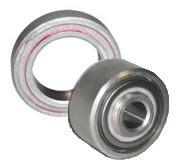
Bearings play an important role in many machines. They are used to reduce friction between moving parts, including shafts and axles. With bearings, machinery parts such as these encounter less resistance when moving. There are different types of bearings, however, such as fluid bearings.
Overview of Fluid Bearings
Fluid bearings are characterized by the presence of a liquid layer. They use a thin layer of a lubricating fluid, such as oil, to reduce friction.
Fluid bearings are commonly used in the following applications:
- Gas turbines
- Automotive
- Aerospace
- Compressors
- Power generators
- Satellites
- Lathes and milling machines
- Navigation systems
- Cooling pumps
How Fluid Bearings Work
Also known as fluid film bearings, fluid bearings work by creating a layer of pressurized fluid between two or more moving parts. Rather than directly touching each other, the parts will be separated by the fluid. As a result, the parts can rotate and move more smoothly.
Fluid bearings can be categorized as hydrodynamic or hydrostatic. They both use fluid to reduce friction, but the way in which they deliver this lubricating fluid varies depending on the type.
Hydrodynamic fluid bearings generate fluid through movement. As the shaft or part begins to rotate, it will pull the fluid into the bearing space. This action creates pressure that helps to reduce friction.
Hydrostatic fluid bearings generate fluid via a pump. They require an external pump to move fluid into the bearing space. Hydrostatic fluid bearings are typically used in applications involving heavy loads or requiring high precision.
Fluid Bearings vs Ball Bearings
Unlike ball bearings, fluid bearings don’t rely on direct contact with the parts with which they are used. Instead, they leverage a thin layer of pressurized fluid. Hydrodynamic fluid bearings generate a layer of fluid from the rotation of a shaft or part, whereas hydrostatic fluid bearings generate a layer of fluid from an external pump.
Ball bearings, on the other hand, reduce friction using a set of balls. The balls are typically confined between an inner and outer ring. These rings or “races” promote smooth movement. The balls will roll within the races, thereby reducing friction. Some ball bearings may also feature a lubricating fluid, but they rely primarily on balls to reduce friction.
In Conclusion
All bearings are used to assist with the movement of parts — and fluid bearings are no exception. Fluid bearings simply use oil or a similar lubricating fluid to reduce friction.



